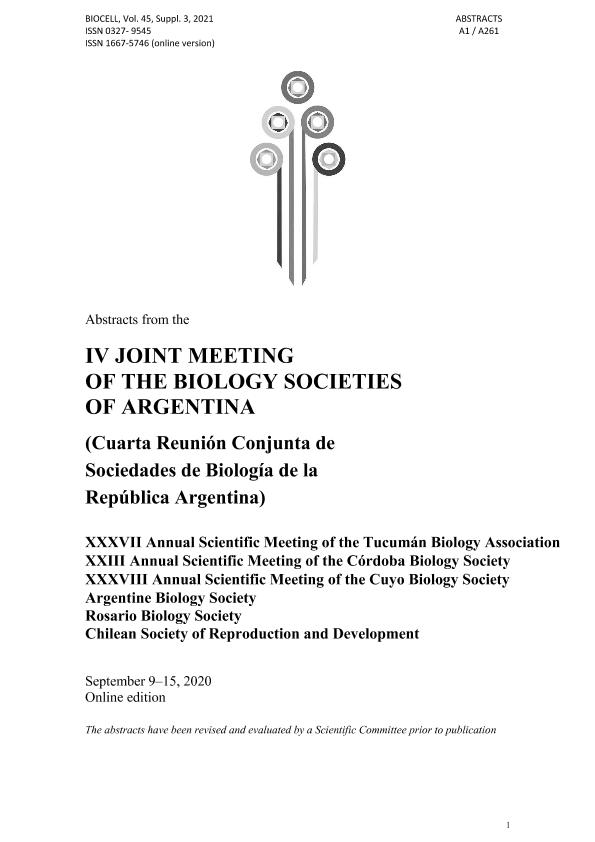Evento
Histological study of human dental alveols treated with xeno-graft in implantology
Jammal, María Victoria ; Juárez, Jorge Nicolás; Schemberger, Viviana Elizabeth; Diaz, Silvana; Garcia, Jorge; Missana, Liliana Raquel
; Juárez, Jorge Nicolás; Schemberger, Viviana Elizabeth; Diaz, Silvana; Garcia, Jorge; Missana, Liliana Raquel
 ; Juárez, Jorge Nicolás; Schemberger, Viviana Elizabeth; Diaz, Silvana; Garcia, Jorge; Missana, Liliana Raquel
; Juárez, Jorge Nicolás; Schemberger, Viviana Elizabeth; Diaz, Silvana; Garcia, Jorge; Missana, Liliana Raquel
Tipo del evento:
Reunión
Nombre del evento:
IV Joint Meeting of The Biology Societies of Argentina
Fecha del evento:
09/09/2020
Institución Organizadora:
Sociedad de Biología de Cuyo;
Sociedad Argentina de Biología;
Sociedad de Biología de Córdoba;
Sociedad de Biología de Rosario;
Asociación de Biología de Tucumán;
Título de la revista:
Biocell
Editorial:
Tech Science Press
ISSN:
0327-9545
e-ISSN:
1667-5746
Idioma:
Inglés
Clasificación temática:
Resumen
Dental implants are the treatment to replace missing teeth. The success of this therapy is achieved if the existing bone is sufficient to surround and stabilize the implant. While, when it is not, the application of a bone graft or substitute is essential. The most widely used is the autograft or autologous bone due to its biocompatibility. However, the market offers other variants, such as bovine bone xenografts that are used in daily practice. The objective of this study was to evaluate 3 bovine xenografts (BIOSS, TIOSS and SYNERGY) applied to alveoli after human extraction during prosthetic rehabilitation with implants. Bone tissue samples were treated with: Group 1, TIOSS; Group 2, BIOSS; Group 3, Synergy; Group 4, without substitute (clot). Histopathological studies were carried out. The interpretation of bone biopsies was made following ISO Standards 10993-6 Year 2007: A- Biocompatibility: inflammation, foreign body reaction (FBR), abscesses, necrosis, fibrosis, macrophages. B- Bone neoformation: type of bone, presence/absence of particles, and rate of resorption. Histometric and statistical studies. The histological results obtained at 4 months were: (A) Biocompatibility: Group 1 – TIOSS: moderate chronic inflammation. Presence of FBR, abundant lymphocytes. Group 2 and 3 – BIOSS and Synergy similar behavior with a few chronic inflammation and absence of FBR. Group 4 (clot) – absence of FBR. None of the cases presented necrosis and/or abscesses. (B Bone neoformation: Group 1 – TIOSS: amorphous particles surrounded by numerous congestive vessels and predominantly lax connective tissue and newly composed bone (38%). Group 2 and 3 – BIOSS and Synergy: particles surrounded by fibrovascularized tissue and newly composed bone (47% BIOSS and 49% Synergy) with abundant fatty bone marrow. Group 4 (clot) – laminar bone type (45%). New bone percentages did not show statistically significant differences (P = 0.2). The reabsorption rate of the particles was low in the 3 substitutes evaluated by their persistence at 4 months post placement in the alveolus. From the results obtained, we conclude that BIOSS and Synergy had better biological behavior due to the absence of FBR. All three stimulated bone neoformation. The low reabsorption rate prevented alveolar bone atrophy after extraction and maintained the dimensions of the receptor zone; beneficial events for the stability of the implant and its osseo integration.
Palabras clave:
BOVINE XENOGRAFTS
,
BONE REGENERATION
,
ALVEOLI
Archivos asociados
Licencia
Identificadores
Colecciones
Eventos (IMMCA)
Eventos de INSTITUTO DE INVESTIGACIONES EN MEDICINA MOLECULAR Y CELULAR APLICADA DEL BICENTENARIO
Eventos de INSTITUTO DE INVESTIGACIONES EN MEDICINA MOLECULAR Y CELULAR APLICADA DEL BICENTENARIO
Eventos(PROIMI)
Eventos de PLANTA PILOTO DE PROC.IND.MICROBIOLOGICOS (I)
Eventos de PLANTA PILOTO DE PROC.IND.MICROBIOLOGICOS (I)
Citación
Histological study of human dental alveols treated with xeno-graft in implantology; IV Joint Meeting of The Biology Societies of Argentina; Mendoza; Argentina; 2020; 36-37
Compartir



